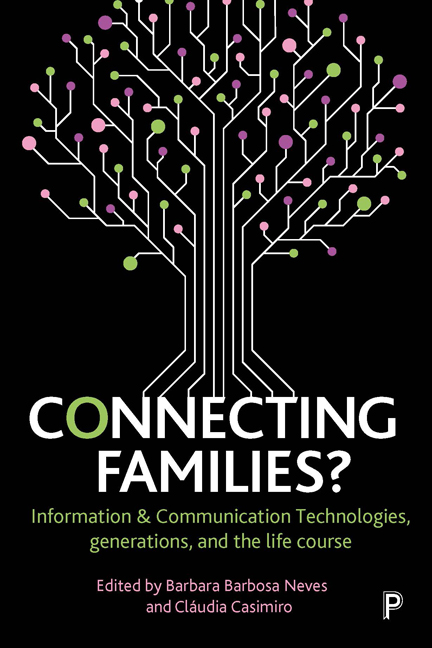Book contents
four - Weaving family connections on- and offline: the turn to networked individualism
Published online by Cambridge University Press: 22 April 2022
Summary
Introduction
Older adults (65+) are now flocking to information and communication technologies (ICTs) in North America after decades of lower usage than that of younger adults (Anderson and Perrin, 2017). With a significant majority of older adults now using ICTs to engage in a range of activities (Anderson and Perrin, 2017), it is important to understand how they use them to shape family life and dynamics. We investigate:
1. What role do ICTs play in supporting family networks in general, and the position of older adults in them?
2. Is ICT use helping to maintain and strengthen social ties within – and across – generations?
These questions are especially important as families in the Global North are in the midst of a societal shift from group-based interaction in a single, local, and often solidary family and community to multiple, loosely knit networks. Such networked individuals have partial membership in multiple networks and rely less on permanent membership in settled groups. They must meet their social and emotional needs by tapping into these loosely knit, often diverse networks rather than relying on tight connections with a relatively small number of family and friends. The shift to networked individualism helps us to understand connectivity across the lifespan, including the role of family connections in the lives of older adults. These are important research and policy matters, especially as some older adults report social isolation and feelings of loneliness (Neves et al, 2017). We contribute to this understanding by examining the role of ICTs in family life from the perspective of older adults.
ICTs are facilitating new forms of social network connections for immediate and extended families, whether it is through email, texting, or more interactive forms of engagement such as video chat. In this chapter, we show how the shift from group-based analysis to examinations of loosely knit networks can help us understand connectivity across the lifespan. We specifically examine how older adults adopt and engage with ICTs and how these technologies are helping to connect families in novel ways. Scholars often include a wide range of technologies under the umbrella term of ‘ICTs’ (Selwyn et al, 2003; Heart and Kalderon, 2013; Chayko, 2017).
- Type
- Chapter
- Information
- Connecting Families?Information and Communication Technologies, Generations, and the Life Course, pp. 59 - 80Publisher: Bristol University PressPrint publication year: 2018
- 1
- Cited by



